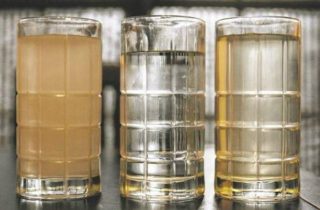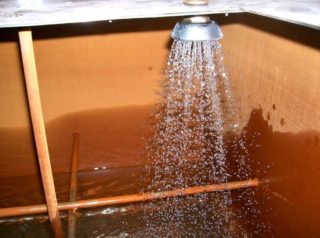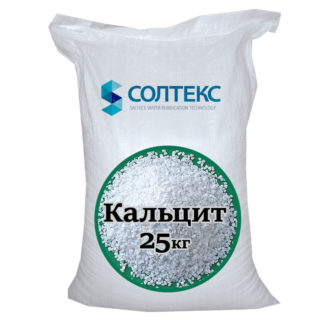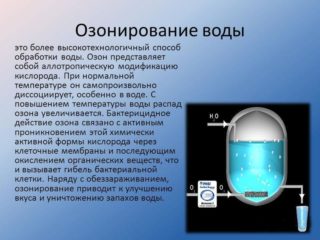The high concentration of minerals in water extracted from wells more than 20 meters deep is not a myth, but a reality that owners of country houses and summer cottages are constantly faced with. With the arrival of spring, “rusty” water appears even in a relatively young and well-equipped well. High mineralization with magnesium and calcium salts makes the water hard and practically unusable, and in the case of iron - dangerous to human health.
Do-it-yourself water purification from iron from a well

Before proceeding with the purification of well water, make sure that it contains a large amount of ferrous iron.
- To be sure of the presence of a chemical, you need to hold a small amount of well water in an open container for a while. At first, it does not manifest itself in any way, but with prolonged contact with air, it precipitates brown color.
- A clear sign of a high concentration of a substance in the water is an unpleasant specific odor from the well.
- It is possible to calculate "by eye" the presence of bacterial iron in water if there are rainbow films on the surface of the water mirror.
The yellow tint of the water indicates an increased content of organic iron (not bacterial!), But it does not precipitate during settling.
To purify water from iron from a well in an old-fashioned way is quite simple and not financially costly.
Upholding
Advantages:
- Mounting a container in the attic will provide gravity, and this will rid the liquid of hydrogen sulfide.
- An easy-to-implement method that does not require large waste.
- There is always a refined volume of liquid in stock.
Among the disadvantages of settling, not 100% water purification is distinguished. The tank also needs to be cleaned regularly, as a dark solid sediment forms on its walls.
Aeration

This method provides excellent cleaning results. The filtration process is quite simple - an oxygen-enriched medium reacts with iron, as a result, the latter decomposes and precipitates. At the outlet after cleaning, the solid particles of the sediment are retained by mechanical filters.
Benefits:
- Purification of well liquid from iron and hydrogen sulfide.
- Environmentally friendly cleaning, as it is a reagent-free method.
Of the shortcomings, only one is distinguished - a small percentage of iron still remains in the composition.
Introduction of catalysts and reagents
In industry, in order to purify liquid from a well, I use chlorine or ozone. The peculiarity of these substances lies in their high oxidizing capacity, however, for their production, special installations are required. It is not recommended to use chemicals at home due to their high toxicity.
As an analogue, it is preferable to use grains or granules of activated glauconite clay, the surfaces of which are equipped with particles of oxidized manganese.
Folk ways

The most common, safe and budgetary way to purify well fluid is to purify streams with lime and then pass through a thick layer of naturally occurring calcite. This process leads to the fact that the iron is transformed into an insoluble salt. Because of this, the water becomes softer and already usable. This method of purification can also be used in cases where the composition of the well fluid fully meets the requirements for use.
Excellent results can be achieved using the dry method. In this case, heated potassium permanganate is used. In a container made of ceramic or fire-resistant glass, approximately 4-5 g of active substance are placed. Potassium permanganate is slowly and carefully warmed up in a sand bath. The container must be covered with a lid. This volume of active ingredient will be sufficient to purify 5 liters of water.
Ozonation
Ozonation is the most reliable and high-quality method of purification. The method is implemented by the action of ozone on the particles contained in the liquid.
By ozonation, organic iron is removed by 99.99%. The disadvantage is that expensive equipment is required for high-quality cleaning. It is realistic to make such a system on your own, but it is very difficult.
Homemade filter for deferrization of water from a well
Ready-made store filters are quite expensive. However, reagent systems for treating well water can be made independently.
To make a filter you will need:
- Two horizontal tanks made of plastic and equipped with a large lid.
- A separate container for the active substance - a free-flowing reagent.
- Fine sieve for collecting large solids.
- A set of plastic pipes, some of them equipped with taps.
The installation location of such a system depends on the frequency and intensity of use. If the water will be treated in winter, it is best to store the system in a heated room. The most suitable place is an attic, second floor or a heated room.
Algorithm for assembling a filter for purifying well water:
- The base for the tank is being installed. It is important that the base is reliable, strong and stable, since the weight of a container filled with water reaches several hundred kilograms.
- The containers are firmly fixed at the base. Connection to the water supply network. A special soldering iron is used to connect fittings and pipes.
- A container filled with a reagent and a sieve for collecting solid impurities are loaded. The amount of reagent used depends on the degree of water contamination and the required volumes of purified water.
The home-made filtration system is not equipped with automatic equipment, so the drain and cleaning is carried out independently.












Hello. I liked your video. Can you give more information about the two filters in series (which are from Leroy). Brand, manufacturer than filled. Thanks in advance